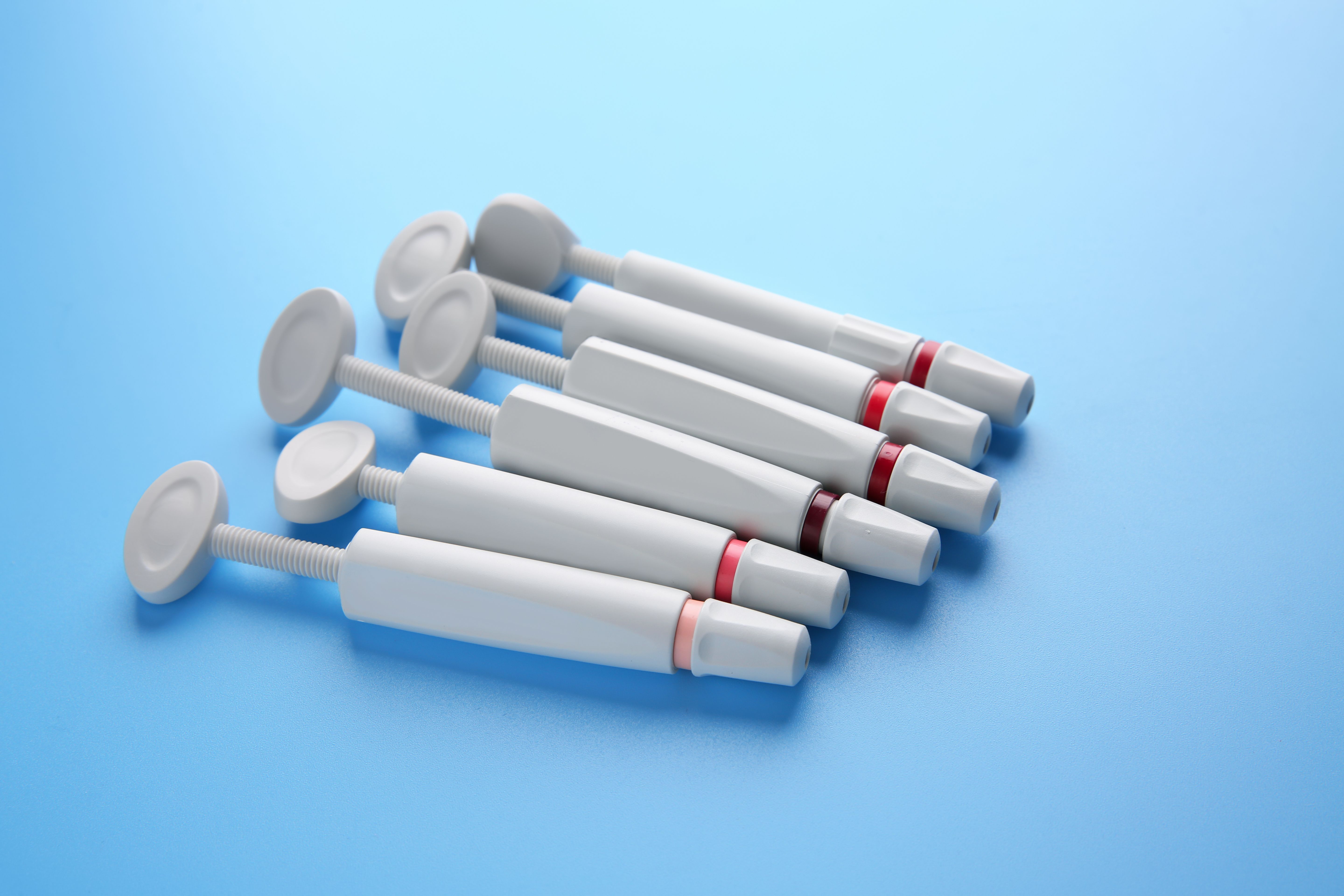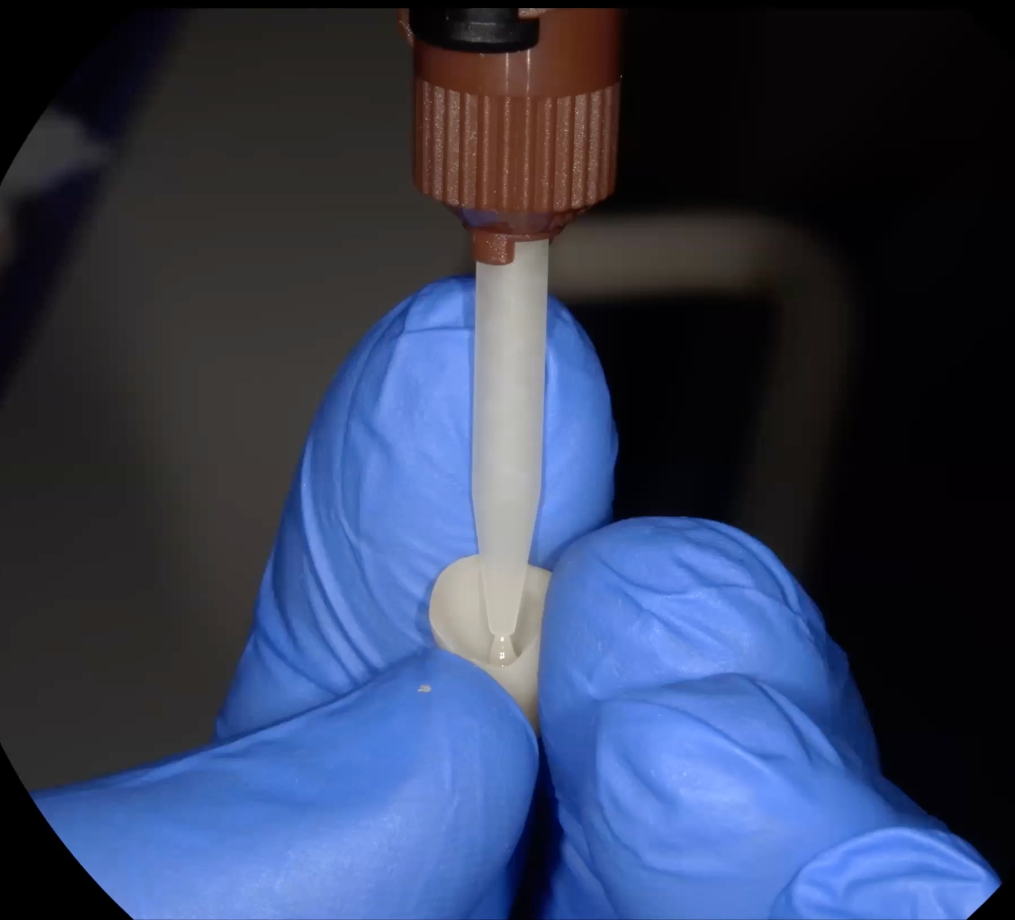What property is most important when choosing a dental adhesive?
Exploring the importance of balancing considerations for dental adhesives.
Syringes of resin luting cements. Pixel-Shot / STOCK.ADOBE.COM

A dream adhesive is one that is effortless to use, creates a strong bond with pristine esthetics, and leaves the patient with zero post-operative sensitivity. Where does one find this perfect adhesive? The bad news is, it doesn’t exist.
So, if you can only have a few of these ideal characteristics, which ones are the most important? Should practitioners be stressing over strong bonds, or focusing on streamlining procedures through ease of use? Are esthetics that important if it means keeping the patient more comfortable?
With each clinical situation being unique, there may not be a definitive answer to these questions. However, some properties stand out above others in terms of importance.
Bond strength
When considering indirect restorations, the ultimate goal is to create a strong, long-lasting bond between the substrate and the dental adhesive, as well as between the adhesive and the restoration. In the end, forming these bonds can mean the difference between restoration success and failure.
“There are many things to take into account, but when I am considering an adhesive, the first thing that I would want to see would be a good five-year clinical trial,” explains Dr. Nathaniel Lawson, director of the division of biomaterials at the University of Alabama at Birmingham School of Dentistry. “And in a clinical trial, I would be considering retention as the primary consideration. Secondary to that, I’d look at staining around the margins”
“In the laboratory, the most critical property we measure on adhesives is bond strength,” Lawson says. “Ideally, bond strength should be measured after at least three months of water storage.”
But with most modern bonding systems meeting—or surpassing—the 30 MPa level, does bond strength become that important of a factor? While bond strength is still a critical consideration, some practitioners feel comfortable assuming that bond strength is a veritable guarantee, since most modern adhesives have the ability to keep a restoration placed for years to come, when implemented and applied properly.
However, the key there is that adhesives must be properly applied. Any issue with isolation, application, light curing or contamination can compromise the strength of a bond.
“If each step is not performed properly, there are some solutions which can be taken afterwards to correct them and form a strong bond—but you’re looking at compromised outcomes,” Lawson explains.
Ease of use
An adhesive with bad handling properties can eat up a lot of procedural time, costing practitioners time and money and increasing the risk of contamination or complications that could ultimately lead to restoration failure. This means ease of use is paramount to restoration success. In fact, almost all doctors surveyed recently by Dental Products Report reported ease of use as a major consideration for adhesives, particularly when trying to save time and maximize productivity.
“As far as adhesives go, the most important thing for me is ease of use,” one doctor states. “Sensitivity reduction is nice, but basically because I work in a public-health office based on seeing as many people as possible (or at least that was the goal pre-COVID), for me it's about saving time.”
Simple handling, consistent viscosity and fewer steps are all important factors that fall under the “ease of use” umbrella and can simplify procedures and streamline workflows. Extended working time and decreased setting time also help speed up procedures, while reducing the risk of contamination. Easy mixing and cleanup are also critical considerations that can make restorations less frustrating for practitioners and patients alike.1
Esthetics
While ensuring a bond stays intact is obviously a critical consideration, the esthetics of a restoration are also essential. With an end goal of trying to ensure a restoration is indistinguishable from the surrounding dentition, it’s extremely important to color match to ensure natural-looking results. This can require a little more finesse—and potentially, extra steps.
For example, light-cured cements are the most color stable, but are not an option in all situations. On the other hand, traditional dual-cure resin cements often discolor and darken over time, or even change shade during curing.
As such, it’s important to consider the procedural steps of an adhesive when thinking about esthetics, as well as the range of shades and viscosities available. To improve esthetics, practitioners should consider adhesives that are simple to dispense, apply and clean up, with viscosity levels that limit drifting after a restoration is seated, and lasting color stability. While this may mean the procedure will take a little longer, it can reinforce long-term esthetic success.
Post-operative sensitivity
No doctor wants to get a call from a patient complaining of post-operative sensitivity a few days (or weeks, or months) after a procedure. Limiting patient discomfort should be a priority for all clinicians. To achieve this, clinicians should do their research on adhesives and know their properties as well as the necessary application steps.
“When evaluating an adhesive in a clinical trial, the third thing I’d look at is post-operative sensitivity,” Lawson says. “That can be a big problem for patients.”
Technique matters when reducing post-op sensitivity. For example, total-etch systems used on dentin require acid etching to open the dentin tubules, subsequently allowing the adhesive to penetrate into the collagen fiber network. If the collagen layer is hydrated, all goes according to plan. If the collagen layer is dry, however, the collagen fibers can collapse, preventing solid adhesion between the substrate and the adhesive. These collapsed collagen fibers contribute greatly to post-op sensitivity.
However, less technique-sensitive self-etch adhesives can reduce this risk of sensitivity. This is because self-etch systems prevent collagen fibers from collapsing, since the material etches and penetrates simultaneously. (This also counteracts the need for moist bonding, eliminating a concern and simplifying the procedure.)
Composite restorations also face the danger of microleakage at the restoration margins due to polymerization shrinkage, which results in the debonding of the restoration and potential enamel cracking. Thus, proper technique to prevent microleakage is critical to reducing post-op sensitivity.
Generations
When evaluating adhesive properties, it’s important to keep in mind that different generations of bonding agents come with different strengths. This means you may have to weigh the cruciality of bond strength against the importance of ease of use or esthetics.
For example, adhesives with the best reputation of clinical success are two-bottle systems, such as fourth- and sixth-generation materials. However, fourth-generation materials remain complex and time consuming to use, requiring multiple steps. The use of multiple bottles and the resulting numerous application steps leave increased room for error.
Sixth-generation systems, while also requiring multiple bottles, introduced self-etching technology, which eliminated the etching step found in fourth- and fifth-generation materials. One downside is that the bond strength of sixth-generation products has been found to decrease significantly over time. If you’re looking for ultimate ease of use, universal adhesives should be a go-to, though since they are newer to the market, their long-term bond strength and efficacy are not as well measured.
Conclusion
Although there’s no one-size-fits all adhesive that’s ideal for all situations, product developers have been getting closer and closer to that end goal. Until then, practitioners should consider which properties matter most on a case-by-case basis and choose an adhesive that meets those goals and works well for them.
References
1. Yu H, Zheng M, Chen R, Cheng H. Proper selection of contemporary dental cements. Oral Health and Dental Management. 2014; 13: 1: 54-49







